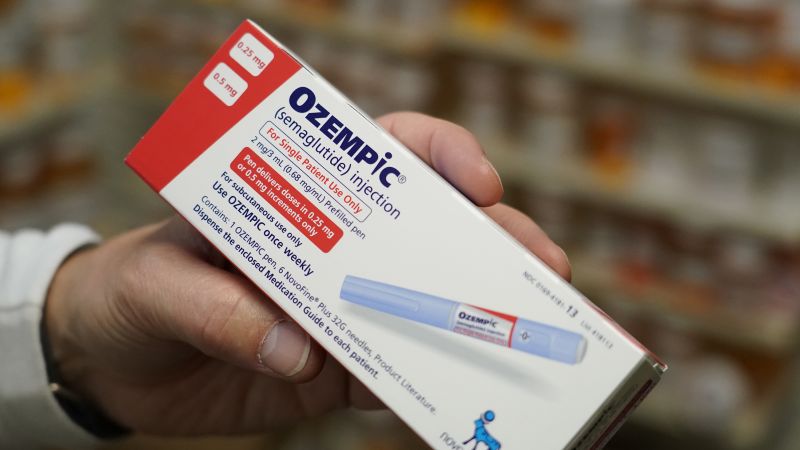George Fry/Bloomberg/Getty Images
A pharmacist holds boxes of Novo Nordisk A/S Ozempic brand semaglutide medication lined up at a pharmacy on Monday, November 27, 2023 in Provo, Utah, USA.
Washington DC
CNN
—
Analysts at Goldman Sachs said in a recent research note that the U.S. economy stands to benefit significantly if Americans take popular weight-loss drugs such as Ozempic and Wigovy. Ta.
These drugs are part of a powerful new class of drugs known as glucagon-like peptide 1 or GLP-1 receptor agonists that have taken the world by storm. Originally developed to treat type 2 diabetes, it was proven to be highly effective in reducing weight in clinical trials. (Ozempic is not approved by regulators as a weight loss drug, but a similar drug, Wigovy, is.)
Goldman Sachs says it is clear that poor health has a negative impact on the economy, so improving health outcomes through GLP-1 has the potential to reduce costs, improve productivity, and boost economic output. claims.
The Wall Street bank says, “In a base scenario in which 30 million users take the drug and 70% see an effect, GLP-1 will exceed US gross domestic product (of all goods and services produced in the economy). We estimate that this could push up the “broader measure” by 0.4%. ”, and up to 1% if the 60 million Americans took those drugs regularly.
The overall US economy was around $28 trillion in the fourth quarter, so if Goldman’s bullish claims are true, GLP-1 drugs alone could more or less increase production by $1 trillion over the next four years. It means that there is.
According to the report, this would be a significant boost to the economy, but the actual magnitude of the impact will also depend on production scale and adherence to treatment regimens, and the potential impact of drug discovery leveraging artificial intelligence and advancements. We are also investigating. With gene editing.
“We view the current wave of healthcare innovation as a promising macro (in addition to human and micro) story with the potential for meaningful economic upside across a range of possible scenarios. ” the analysts wrote.
Years of research show that poor health has a clear negative impact on Americans in the job market, forcing some workers to take time out of work or reduce their hours.
Combined with “current losses in working hours and labor force participation due to illness, disability, premature mortality, and informal caregiving,” poor health conditions are depressing U.S. economic output. Analysts at Goldman Sachs estimate it to be about 10% annually.
Obesity and its associated complications contribute to labor supply constraints in the United States. According to government statistics, more than a third of Americans are overweight and more than 42% are obese. Another survey found that nearly half of American adults said they had tried to lose weight in the past year.
“Academic research shows that obese people are less likely to work and, when they do, are less productive,” the Goldman Sachs report said.
“These estimates suggest that if the recent wave of medical innovation leads to improved health outcomes and reduces the economic burden of poor health, economic output could pick up significantly,” the analysts said. writing.
GLP-1 has become so popular that pharmaceutical companies are having to ramp up supply to meet surging demand. Novo Nordisk and Eli Lilly, which has its own GLP-1 diabetes drug Munjaro, are investing billions of dollars to expand production capacity.
For some Americans who are obese but not diabetic, those drugs have become difficult, if not impossible, to obtain. So says Jodi Dusha, an endocrinologist at Beth Israel Deaconess Medical Center, in a recent opinion piece for CNN.
Novo Nordisk, which makes Wigovy, recently began increasing the drug’s availability to Americans “by more than doubling the amount of Wigovy’s lower-dose strength compared to last month,” a company official said. Doug Langa said. A representative for North American operations said on a conference call with analysts earlier this month.
This drug is also known to be expensive, and has become even more expensive in recent years. Novo Nordisk raised the list price of Ozempic by 3.5% in January to $969 for a four-week supply, while Eli Lilly last month raised the price of Munjaro by 4.5% for a four-week supply, according to the nonprofit organization 46Brooklyn. The price was set at $1,069. Drug price analysis company. The final price Americans pay for drugs is determined by their health insurance contracts, not by drug companies’ list prices.
#Goldman #Sachs #predicts #drugs #Ozempic #Wigovy #boost #U.S #economy #trillion #years #CNN #Business
